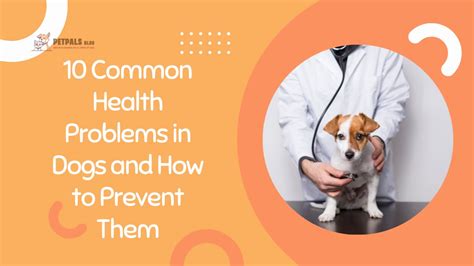Are you a dog owner looking to ensure the best possible health for your furry friend? Just like humans, dogs can also be prone to various health issues based on their breed and physical characteristics. In this blog post, we will delve into the common health issues that affect different dog breeds and how you can take preventive measures to ensure your pet stays happy and healthy.
From hip dysplasia in large breeds to dental issues in toy breeds, we will explore the causes, symptoms, and most importantly, the preventive measures for these health concerns. By being proactive and understanding the unique health risks associated with specific breeds, you can help your dog live a long and fulfilling life. So, whether you have a deep-chested dog prone to bloat or a small breed at risk of heart disease, this post will provide valuable insights on how to recognize and prevent these common health issues. Stay tuned for expert tips and advice on safeguarding your dog’s well-being.
Hip Dysplasia in Large Breeds and How to Prevent It
Hip dysplasia is a common skeletal condition that affects large dog breeds, such as German Shepherds, Labrador Retrievers, and Great Danes. It is a genetic disorder that causes the hip joint to develop improperly, leading to pain, discomfort, and loss of mobility in the affected dogs. Owners of large breed dogs need to be aware of the signs and symptoms of hip dysplasia in order to take preventive measures and provide the best possible care for their pets.
One of the key factors in preventing hip dysplasia in large breeds is maintaining a healthy weight. Excess body weight can exacerbate the symptoms of hip dysplasia and make it more difficult for the dog to move around comfortably. It’s important for large breed dogs to be fed a balanced diet and to engage in regular exercise to keep their joints and muscles strong and healthy.
Another important aspect of preventing hip dysplasia in large breeds is responsible breeding practices. Dog breeders should screen their breeding stock for hip dysplasia and only breed dogs that have been certified as free from the condition. This can help reduce the prevalence of hip dysplasia in future generations of large breed dogs.
Regular veterinary check-ups and early intervention are also crucial in preventing hip dysplasia. Veterinarians can perform diagnostic tests and provide treatment options to help manage the symptoms of hip dysplasia and improve the quality of life for affected dogs. By staying proactive and attentive to their dog’s health, owners can take necessary steps to prevent or mitigate the effects of hip dysplasia in their large breed pets.
Bloat in Deep-Chested Dogs: Causes and Preventive Measures
One of the most serious and life-threatening conditions that can affect deep-chested dogs is bloat, also known as gastric dilatation-volvulus (GDV). This condition occurs when a dog’s stomach fills with gas, fluid, or food and then rotates, trapping the contents and cutting off blood flow.
Several factors can contribute to the development of bloat in deep-chested dogs, including excessive eating or drinking, vigorous exercise after eating, and stress. Additionally, dogs with a family history of bloat or those who have already experienced one episode are at a higher risk. It is crucial for deep-chested dog owners to be aware of these risk factors in order to prevent the occurrence of bloat.
Preventive measures for bloat in deep-chested dogs include feeding multiple small meals per day instead of one large meal, limiting exercise before and after eating, and preventing stress and anxiety. It is also important to ensure that your dog eats from a raised food bowl, as this can reduce the amount of air they swallow while eating. Moreover, timely veterinary intervention is vital in preventing bloat, as your vet can perform a gastropexy to surgically attach your dog’s stomach to the abdominal wall, reducing the risk of rotation.
Overall, bloat is a life-threatening condition that requires quick action, so it is essential for deep-chested dog owners to be well-informed about the causes and preventive measures to ensure the health and well-being of their beloved pets.
Allergies in Dogs: Identifying Triggers and Prevention
Identifying allergies in dogs can be a challenging task for pet owners. Allergies in dogs can be caused by a variety of factors, including environmental triggers, food allergies, and even flea bites. It’s important to be able to recognize the signs of allergies in your dog so that you can take steps to prevent and manage their symptoms.
One of the most common signs of allergies in dogs is itching. If you notice your dog scratching excessively, licking their paws, or rubbing their face against objects, they may be experiencing an allergic reaction. Other symptoms of allergies in dogs can include red, inflamed skin, ear infections, and gastrointestinal issues such as vomiting and diarrhea.
To identify the specific triggers of your dog’s allergies, it may be necessary to work with a veterinarian. Allergy testing can help to pinpoint the exact cause of your dog’s symptoms, whether it’s a certain type of pollen, a specific ingredient in their food, or an allergen present in your home environment. Once you have identified the triggers, you can take steps to minimize your dog’s exposure to them.
Preventing allergies in dogs often involves making changes to their diet, lifestyle, and environment. This may include switching to a hypoallergenic dog food, using air purifiers in your home, and avoiding walks in areas with high pollen counts. Regular grooming and regular flea prevention can also help to reduce the risk of allergic reactions in dogs.
Obesity in Dogs: Causes, Consequences, and Weight Management
Obesity in dogs is a serious issue that can have detrimental effects on their overall health and well-being. Just like in humans, obesity in dogs can be caused by a combination of factors including overfeeding, lack of exercise, and genetic predisposition. It’s important for dog owners to recognize the signs of obesity in their pets, such as a visible waistline, difficulty breathing, and lethargy, in order to take preventive measures.
Consequences of obesity in dogs can be severe, leading to a higher risk of developing serious health conditions like diabetes, arthritis, and heart disease. Additionally, obesity can exacerbate existing health issues and reduce the dog’s overall lifespan. It’s crucial for pet owners to understand the potential consequences of allowing their dogs to become overweight, and take action to prevent it.
Weight management in dogs is essential for preventing and treating obesity. This can be achieved through a combination of portion control, regular exercise, and a balanced diet. Consulting with a veterinarian to develop a customized weight management plan is important, as every dog has different dietary and exercise needs. By taking proactive steps to manage their dog’s weight, owners can help their pets lead healthier and happier lives.
Ultimately, obesity in dogs is a significant health concern that requires attention and proactive management from pet owners. By understanding the causes, consequences, and effective weight management strategies, dog owners can help prevent obesity and improve the overall quality of life for their beloved pets.
Heart Disease in Small Breeds: Early Detection and Prevention
Heart disease is a common health issue in small dog breeds, making early detection and prevention crucial for their overall well-being. It is important for pet owners to be aware of the symptoms and risk factors associated with heart disease in small breeds, as this knowledge can aid in early detection and timely intervention.
One of the most common forms of heart disease in small dog breeds is degenerative mitral valve disease (DMVD). This condition affects the heart’s mitral valve, leading to symptoms such as coughing, difficulty breathing, and decreased exercise tolerance. Regular veterinary check-ups are essential for monitoring the heart health of small breeds and identifying any signs of DMVD early on.
Preventive measures such as maintaining a balanced diet, regular exercise, and weight management can play a crucial role in reducing the risk of heart disease in small breeds. Providing a low-sodium diet, avoiding obesity, and incorporating heart-healthy supplements can help support cardiovascular health and minimize the onset of heart disease.
In addition to proactive lifestyle choices, pet owners should be vigilant about early detection by recognizing subtle changes in their dog’s behavior and physical condition. Seeking prompt veterinary care in the event of any concerning symptoms can make a significant difference in managing heart disease in small breeds and improving their quality of life.
Joint Problems in Aging Dogs: Maintaining Mobility and Comfort
As dogs age, they are prone to developing joint problems that can affect their mobility and comfort. Conditions such as arthritis and hip dysplasia are common in aging dogs, leading to pain and stiffness in their joints. It is essential for dog owners to recognize the signs of joint problems and take preventive measures to maintain their pet’s mobility and comfort.
Regular exercise is crucial in managing joint problems in aging dogs. Low-impact activities such as swimming and gentle walks can help improve muscle strength and flexibility, reducing the discomfort associated with stiff joints. Additionally, maintaining a healthy weight through proper diet and portion control can also alleviate the strain on the dog’s joints, minimizing the progression of joint problems.
Providing a comfortable and supportive environment for aging dogs is essential in preventing further joint issues. Investing in orthopedic beds and supportive ramps can make it easier for dogs to navigate their surroundings without putting excessive strain on their joints. Regular visits to the veterinarian can also aid in early detection and management of joint problems, ensuring that the dog receives appropriate treatment and care.
In conclusion, joint problems in aging dogs can significantly impact their mobility and comfort. By implementing preventive measures such as regular exercise, weight management, and creating a supportive environment, dog owners can help alleviate the discomfort associated with joint issues, allowing their pets to enjoy a higher quality of life in their later years.
Dental Issues in Toy Breeds: Oral Hygiene Tips and Preventive Care
Toy breeds are adorable and make wonderful pets, but they are also prone to dental issues due to their small size and delicate jaws. It is essential for pet owners to be proactive in maintaining their toy breed’s oral hygiene to prevent dental problems from occurring.
Regular brushing is the first line of defense against dental issues in toy breeds. Using a small, soft-bristled toothbrush and toothpaste designed specifically for dogs, gently brush your pet’s teeth at least two to three times a week. This will help to remove plaque and prevent tartar buildup, reducing the risk of dental disease.
In addition to regular brushing, providing chew toys and dental treats can also aid in maintaining your toy breed’s oral health. Chew toys help to scrape off plaque and tartar, while dental treats contain ingredients that can help prevent the formation of dental issues.
Regular dental check-ups with a veterinarian are crucial for toy breeds to detect any dental problems early on. Your vet can perform a thorough examination of your pet’s mouth and recommend professional cleaning or any necessary dental treatments to prevent dental issues from progressing.
Eye Disorders in Specific Dog Breeds: Recognizing and Preventing
Eye Disorders in Specific Dog Breeds: Recognizing and Preventing
Eye disorders in specific dog breeds can be a real concern for pet owners. Certain breeds are more prone to eye problems due to genetics, conformation, or environmental factors. It’s important for dog owners to be aware of the signs and symptoms of common eye disorders in their specific breed, as well as take preventive measures to ensure their dog’s ocular health.
Recognizing the signs of eye disorders in specific dog breeds is crucial for early detection and treatment. Some common signs of eye problems in dogs include redness, cloudiness, excessive tearing, squinting, pawing at the eyes, and changes in the appearance of the eyes. It’s important to monitor your dog’s eyes regularly for any changes and seek veterinary attention if you notice any abnormalities.
Preventing eye disorders in specific dog breeds can be challenging, but there are steps that pet owners can take to minimize the risk. Regular eye exams by a veterinarian are essential for early detection of any issues. Additionally, keeping your dog’s eyes clean and free of debris can help prevent infections and irritation. Providing a healthy diet and proper grooming can also support overall ocular health.
By recognizing the signs of eye disorders and taking preventive measures, dog owners can help maintain the ocular health of their beloved pets. It’s important to stay informed about the specific eye-related concerns of your dog’s breed and work closely with a veterinarian to address any issues that may arise.





